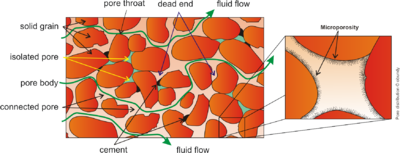User:Rizqi Fadlilah/Sandbox
PREFACE
Reservoir rock have many lithologies like sandstones, limestones, granitic, tuff, and shale. Reservoir filled by hydrocarbon on fracture or pores. All reservoir hydrocarbon content connate water . some reservoir content connate water in the micropore that content 10-60% from the pores volume.
Information about scale factor needed to conceptualized reservoir. Scale factor can differences by microscopic; relates to pores and sand grains, macroscopic; relates to conventional core-plug scale, megascopic relates to the scale of grid-blocks in simulation models, and gigascopic relates to regional scale.
Homogeneity and heterogeneity
Homogeneity factor consist uniform material. Homogeneity factor is similar depositional environment, grain distribution is relatively similar, and similar kind of intensity diagenesa. While the heterogeneity factors is changes in depositional environment, sedimentary material, grain size distribution, and facies, also different type and intensity of diagenesis processes.
Pore structure and geometry
Pore structure varies with the size, shape, and composition of natural grains, as well as fractures. Geometry ranging from <1 micron to 100 micron . Pore characteristic will determine oil recovery method.
Reservoir pressure
Fluid in reservoir have hydrostatic pressure that associated reservoir system. Pressure from overburden rock also press the pore and increase the fluid pressure.
Temperature reservoir
Temperature at some depth comes from gradient geothermal and it is directly proportional to the depth.
Reservoir boundary
Reservoir bounded by impermeable layers and fluid contact. Field boundaries is ensured through the well but based on well data; electric logs, well flow testing, and repeat formation tester (RFT). Boundary of water and hydrocarbon zones is reduced gradually. This saturation interval resulted in the transition zone. This zone is used as perforation zone in production well.
Physical properties of rocks
Porosity (Phi) 5, permeability (k) mD, fluid saturation (S) %, capiler pressure (Pc) Psi, compressibility (C) Psi^-1, resistivity (R) ohm.
Porosity
Porosity is the amount of free space compared to the bulk volume of rock. Porosity affects the ability of the rock to keep the fluid inside the pores of the rock. The pores can be interconnected and isolated. The pores are interconnected referred to as the effective porosity. Total porosity of rock is a combination of pore volume and pore volume isolated interconnected. While porosity very small called microporosity. Connate water is stored in this microporosity.
Formula for absolute porosity
Formula for effective porosity
Permeability
Permeability is the ability of the rock to drain fluid (hydraulic conductivity) through the pores of the rock. The bigger the pore throat more easily drain the fluid. Unit permeability is miliDarcy.
- Absolute permeability (Ka)
Absolute permeability retrieved from conventional core analysis or by the approach through equations based on log analysis. Empirical equation that can be used is :
- Effective permeability (Kef)
Measurements can be made directly at the reservoir scale well test analysis. Direct measurement is only valid on the condition that a constant fluid saturation. In the analysis of special core analysis laboratory with a known value of relative permeability. Relative permeability equation for Corey Model is:
With effective permeability is :
Fluid saturation (S)
A fraction of the level of pore space is filled by a fluid.
Capillarity
Capillarity is the power of pressure between the two types of fluid immissicible. Based on capillarity power will be able to determine the level of the fluid content wettability of rock. The cut off limit wettability is θ = 90°.






